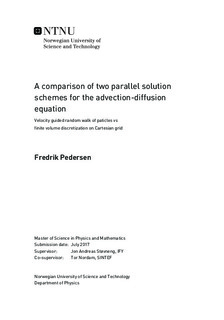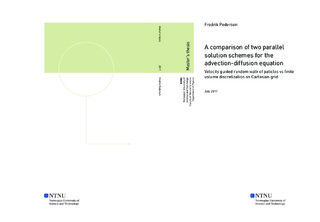| dc.contributor.advisor | Støvneng, Jon Andreas | |
| dc.contributor.advisor | Nordam, Tor | |
| dc.contributor.author | Pedersen, Fredrik | |
| dc.date.accessioned | 2017-10-02T14:00:48Z | |
| dc.date.available | 2017-10-02T14:00:48Z | |
| dc.date.created | 2017-07-05 | |
| dc.date.issued | 2017 | |
| dc.identifier | ntnudaim:16902 | |
| dc.identifier.uri | http://hdl.handle.net/11250/2457806 | |
| dc.description.abstract | In this thesis two methods for solving the diffusion-advection equation was implemented using MPI. The two methods was a velocity guided random walk of particles and solving the advection-diffusion equation on a grid. Both systems was solved for double vortex velocity system with reflective boundaries. Both implementations was shown to be sufficient solutions to the advection-diffusion equation. The computation time of the model using velocity guided random walk of particles is highly affected by the mapping method from particles to grid, as the mapping influence the number of particles needed to get a sufficient picture. Using a "boxcount" method for mapping the particles, the total number of particles are needed to so large that computational time for the random walk model is significantly larger than the grid model. The implementation of both methods show reasonable scaling as the number of the number of processor increase up to $512$ and $1024$. The grid model exhibit super linear speedup, probably due to better usage of cache. | |
| dc.language | eng | |
| dc.publisher | NTNU | |
| dc.subject | Fysikk og matematikk, Teknisk fysikk | |
| dc.title | A comparison of two parallel solution schemes for the advection-diffusion equation - Velocity guided random walk of paticles vs finite volume discretization on Cartesian grid | |
| dc.type | Master thesis | |

